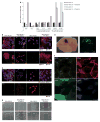Neurotrophin-3 modulates breast cancer cells and the microenvironment to promote the growth of breast cancer brain metastasis
- PMID: 23001042
- PMCID: PMC3998718
- DOI: 10.1038/onc.2012.417
Neurotrophin-3 modulates breast cancer cells and the microenvironment to promote the growth of breast cancer brain metastasis
Abstract
Metastasis, which remains incompletely characterized at the molecular and biochemical levels, is a highly specific process. Despite the ability of disseminated cancer cells to intravasate into distant tissues, it has been long recognized that only a limited subset of target organs develop clinically overt metastases. Therefore, subsequent adaptation of disseminated cancer cells to foreign tissue microenvironment determines the metastatic latency and tissue tropism of these cells. As a result, studying interactions between the disseminated cancer cells and the adjacent stromal cells will provide a better understanding of what constitutes a favorable or unfavorable microenvironment for disseminated cancer cells in a tissue-specific manner. Previously, we reported a protein signature of brain metastasis showing increased ability of brain metastatic breast cancer cells to counteract oxidative stress. In this study, we showed that another protein from the brain metastatic protein signature, neurotrophin-3 (NT-3), has a dual function of regulating the metastatic growth of metastatic breast cancer cells and reducing the activation of immune response in the brain. More importantly, increased NT-3 secretion in metastatic breast cancer cells results in a reversion of mesenchymal-like (EMT) state to epithelial-like (MET) state and vice versa. Ectopic expression of NT-3 in EMT-like breast cancer cells reduces their migratory ability and increases the expression of HER2 (human epidermal growth factor receptor 2) and E-cadherin at the cell-cell junction. In addition, both endogenous and ectopic expression of NT-3 reduced the number of fully activated cytotoxic microglia. In summary, NT-3 appears to promote growth of metastatic breast cancer cells in the brain by facilitating the re-epithelialization of metastatic breast cancer cells and downmodulating the cytotoxic response of microglia. Most importantly, our results provide new insights into the latency and development of central nervous system macrometastases in patients with HER2-positive breast tumors and provide mechanistic rationale to target HER2 signaling for HER2-positive breast cancer brain metastasis.
Conflict of interest statement
The authors declare no conflict of interest.
Figures








Similar articles
-
Cooperation of neurotrophin receptor TrkB and Her2 in breast cancer cells facilitates brain metastases.Breast Cancer Res. 2017 Apr 26;19(1):51. doi: 10.1186/s13058-017-0844-3. Breast Cancer Res. 2017. PMID: 28446206 Free PMC article.
-
FABP7 is a key metabolic regulator in HER2+ breast cancer brain metastasis.Oncogene. 2019 Sep;38(37):6445-6460. doi: 10.1038/s41388-019-0893-4. Epub 2019 Jul 19. Oncogene. 2019. PMID: 31324889 Free PMC article.
-
Epithelial requirement for in vitro proliferation and xenograft growth and metastasis of MDA-MB-468 human breast cancer cells: oncogenic rather than tumor-suppressive role of E-cadherin.Breast Cancer Res. 2017 Jul 27;19(1):86. doi: 10.1186/s13058-017-0880-z. Breast Cancer Res. 2017. PMID: 28750639 Free PMC article.
-
Molecular and cellular mechanisms underlying brain metastasis of breast cancer.Cancer Metastasis Rev. 2020 Sep;39(3):711-720. doi: 10.1007/s10555-020-09881-y. Cancer Metastasis Rev. 2020. PMID: 32399646 Free PMC article. Review.
-
Immune Microenvironment of Brain Metastases-Are Microglia and Other Brain Macrophages Little Helpers?Front Immunol. 2019 Aug 20;10:1941. doi: 10.3389/fimmu.2019.01941. eCollection 2019. Front Immunol. 2019. PMID: 31481958 Free PMC article. Review.
Cited by
-
Unveiling the Neural Environment in Cancer: Exploring the Role of Neural Circuit Players and Potential Therapeutic Strategies.Cells. 2023 Aug 3;12(15):1996. doi: 10.3390/cells12151996. Cells. 2023. PMID: 37566075 Free PMC article. Review.
-
Tumor-associated and disease-associated autoantibody repertoires in healthy colostrum and maternal and newborn cord sera.J Immunol. 2015 Jun 1;194(11):5272-81. doi: 10.4049/jimmunol.1402771. Epub 2015 Apr 27. J Immunol. 2015. PMID: 25917091 Free PMC article.
-
Prophylactic TLR9 stimulation reduces brain metastasis through microglia activation.PLoS Biol. 2019 Mar 28;17(3):e2006859. doi: 10.1371/journal.pbio.2006859. eCollection 2019 Mar. PLoS Biol. 2019. PMID: 30921319 Free PMC article.
-
Role of the nervous system in cancer metastasis.J Exp Clin Cancer Res. 2018 Jan 15;37(1):5. doi: 10.1186/s13046-018-0674-x. J Exp Clin Cancer Res. 2018. PMID: 29334991 Free PMC article. Review.
-
The Role of Microglia in Brain Metastases: Mechanisms and Strategies.Aging Dis. 2024 Feb 1;15(1):169-185. doi: 10.14336/AD.2023.0514. Aging Dis. 2024. PMID: 37307835 Free PMC article. Review.
References
Publication types
MeSH terms
Substances
Grants and funding
LinkOut - more resources
Full Text Sources
Medical
Research Materials
Miscellaneous

